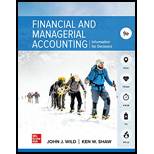
Concept explainers
Free on board:
Free on Board in short known as FOB, defines whether a buyer or a seller will be responsible for the ownership of the goods based on the geographical location of the goods and the contract entered there in. There are two types of FOB –FOB Shipping and FOB Destination.
FOB shipping: Under this contract when the goods are placed at the port for the shipment, the ownership of the goods transfers to the buyer. And now the buyer will incur the expenses (freight expense or the transportation expense) or even the loss if anything happens to the goods, from the point of goods placed for delivery.
FOB destination: Under this contract until the goods does not reaches the delivery point of the buyer, the ownership of goods remain with the seller. Thus the seller will incur the expense or the loss if anything happens to the goods before being delivered to the buyer at the stated delivery location.
Inventory: Inventory refers to the stock or goods which will be sold in the near future and thus is an asset for the company. It comprises of the raw materials which are yet to be processed, the stock which is still going through the process of production and it also includes completed products that are ready for sale. Thus inventory is the biggest and the important source of income and profit for the business.
Consignment: Consignment is an agreement between the seller and the agent wherein the agent takes the responsibility of selling the goods on the seller‘s behalf to the buyer or the third party though the ownership of the goods remains with the seller until goods are sold to the actual buyer.
Consignor: The one who discharges the duty of selling the products to the ultimate buyer to an agency or an agent is known as the consignor.
Consignee: The one who works as an agent for a seller and takes the responsibility to vend or sell the goods by charging commission for the same is the consignee.
To identify: 1.The closing inventory amount to be included in the
2. Consignor and consignee in case of the two companies and the company which will include the unsold goods as a part of its inventory
Want to see the full answer?
Check out a sample textbook solution
Chapter 5 Solutions
Financial and Managerial Accounting
- Consider the following information for Trent Company: Net cash provided by operating activities $1,000,000 Common stock issued as a result of a stock dividend (fair value) 100,000 Common stock issued for cash 400,000 Proceeds from sale of building 300,000 Trent Company should report a net increase in cash of:arrow_forwardPlease explain the solution to this general accounting problem with accurate principles.arrow_forwardPlease explain the solution to this general accounting problem using the correct accounting principles.arrow_forward
- I need the correct answer to this general accounting problem using the standard accounting approach.arrow_forwardI am searching for the accurate solution to this general accounting problem with the right approach.arrow_forwardPlease provide the correct answer to this general accounting problem using valid calculations.arrow_forward

 AccountingAccountingISBN:9781337272094Author:WARREN, Carl S., Reeve, James M., Duchac, Jonathan E.Publisher:Cengage Learning,
AccountingAccountingISBN:9781337272094Author:WARREN, Carl S., Reeve, James M., Duchac, Jonathan E.Publisher:Cengage Learning, Accounting Information SystemsAccountingISBN:9781337619202Author:Hall, James A.Publisher:Cengage Learning,
Accounting Information SystemsAccountingISBN:9781337619202Author:Hall, James A.Publisher:Cengage Learning, Horngren's Cost Accounting: A Managerial Emphasis...AccountingISBN:9780134475585Author:Srikant M. Datar, Madhav V. RajanPublisher:PEARSON
Horngren's Cost Accounting: A Managerial Emphasis...AccountingISBN:9780134475585Author:Srikant M. Datar, Madhav V. RajanPublisher:PEARSON Intermediate AccountingAccountingISBN:9781259722660Author:J. David Spiceland, Mark W. Nelson, Wayne M ThomasPublisher:McGraw-Hill Education
Intermediate AccountingAccountingISBN:9781259722660Author:J. David Spiceland, Mark W. Nelson, Wayne M ThomasPublisher:McGraw-Hill Education Financial and Managerial AccountingAccountingISBN:9781259726705Author:John J Wild, Ken W. Shaw, Barbara Chiappetta Fundamental Accounting PrinciplesPublisher:McGraw-Hill Education
Financial and Managerial AccountingAccountingISBN:9781259726705Author:John J Wild, Ken W. Shaw, Barbara Chiappetta Fundamental Accounting PrinciplesPublisher:McGraw-Hill Education





